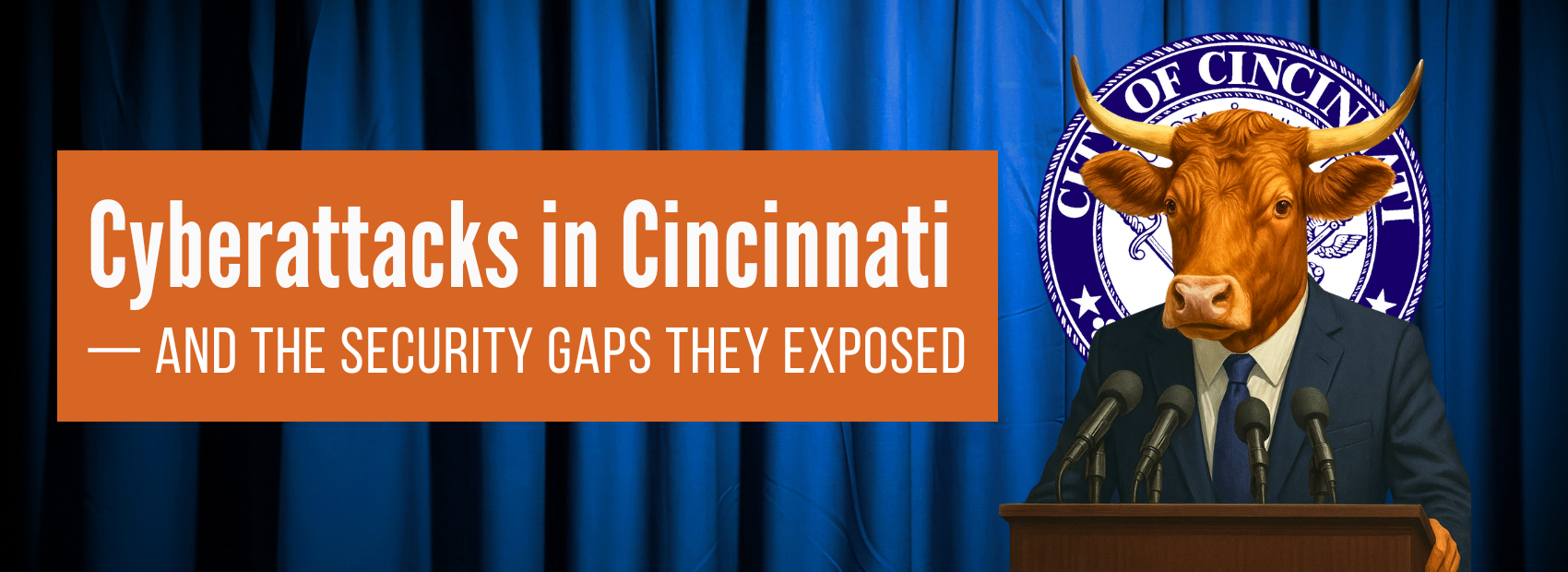Recent Cyberattacks in Cincinnati: How Hackers Exploited Security Gaps Across Local Industries
Cyberattacks aren’t just a Silicon Valley or Wall Street problem anymore. Over the past few years, Greater Cincinnati and Northern Kentucky have quietly but steadily become one of the Midwest’s most active battlegrounds for ransomware, phishing, and data breaches.
From hospitals to schools to city halls, no sector has been spared. Hospitals have canceled surgeries. School districts have gone dark. Local governments have seen sensitive records stolen. Taken together, these events have gradually chipped away at the illusion that “it couldn’t happen here.”
For small and mid-sized business owners across the Tri-State, these attacks are far more than distant headlines — they’re local case studies. Each one reveals what happens when cybersecurity becomes an afterthought — and, more importantly, what proactive organizations can do differently.
1. Kettering Health: When Healthcare Stopped
In May 2025, patients across southern Ohio arrived at hospitals only to find canceled appointments, delayed procedures, and systems suddenly offline. Kettering Health — a major healthcare network serving communities throughout the Cincinnati-Dayton corridor — had become the latest victim of a large-scale ransomware attack.
What happened:
The Interlock ransomware group infiltrated systems across 14 hospitals and over 120 outpatient sites. Electronic records froze. Appointments were canceled. Critical departments reverted to paper.
Why it matters:
Hospitals operate on a principle of urgency, which is precisely what hackers exploit. Attackers know that downtime in healthcare can put lives at risk, increasing the odds of a ransom payout.
Root cause:
According to cybersecurity researchers at the University of Cincinnati, healthcare networks are notoriously fragmented. They rely on a patchwork of connected devices, outdated software, and third-party portals — each one a potential weak link.
Key takeaway for local businesses:
If your business depends on uptime — even for operations, scheduling, or billing — your risk profile looks a lot like Kettering’s. Don’t wait for a crisis to realize that redundancy, monitoring, and offsite backups aren’t “extras”; they’re business continuity essentials.
2. Cincinnati Public Schools: The Cost of a Click
In 2024, Cincinnati Public Schools (CPS) confirmed it had been hit by a ransomware attack that exposed roughly 177 gigabytes of sensitive staff and student data.
The Ransomhub group claimed responsibility, publishing sample files to prove their access. District leaders had to notify thousands of families, while cybersecurity teams worked around the clock to restore operations before the start of the school year.
How it happened:
Investigations pointed to a phishing email that compromised administrative credentials — a single user’s mistake that cascaded into systemwide chaos.
Why it matters:
Education systems are uniquely vulnerable. They hold troves of personal data but often lack the budget or technical staff to build enterprise-level defenses.
For business owners, the lesson is clear:
Cybersecurity isn’t just about software — it’s about people.
Your best firewall might be an employee who knows what not to click.
Actionable insights:
-
Conduct quarterly phishing simulations.
-
Require multi-factor authentication (MFA) for email and file sharing.
-
Rotate passwords regularly — and ban reuse across systems.
3. Cincinnati State: When Higher Education Went Offline
Back in 2022, Cincinnati State Technical and Community College learned firsthand how a single intrusion can paralyze an entire institution.
The Vice Society ransomware gang infiltrated the college’s servers, exfiltrated confidential data, and published it on the dark web. Class schedules were disrupted. Faculty emails went down. Even basic administrative tasks — payroll, transcripts, financial aid — were delayed for weeks.
Why this one stood out:
It wasn’t just about stolen data. It was about dependency. Cincinnati State had digitized nearly every process — from classroom tools to HR systems — without proportionally scaling its cybersecurity defenses.
The local lesson:
Small organizations (including most colleges, nonprofits, and family-owned companies) often underestimate how interconnected their systems are. When one piece falls, everything stops.
Key takeaways:
-
Conduct an annual audit of all connected systems and vendors.
-
Don’t assume your cloud provider is automatically “secure.”
-
Test your backups regularly — a backup that fails to restore is just digital decor.
4. Greater Cincinnati Behavioral Health: Data With a Human Cost
In December 2023, Greater Cincinnati Behavioral Health Services (GCBHS) disclosed a breach that affected roughly 62,000 patients.
Mental health data is among the most sensitive information any organization can hold — not just because it’s private, but because it can directly affect patients’ lives, jobs, and relationships. The attackers disrupted systems, forcing the organization to revert to manual intake and communication.
What caused it:
The breach began with a compromised user account that granted deeper access to internal records. The attackers moved laterally across servers before detection tools triggered alerts.
Why it matters for local professionals:
Every business — whether a medical office, CPA firm, or property management company — stores sensitive client data. Even if you’re not a healthcare provider, exposure of financial, legal, or personal information can trigger fines, lawsuits, or loss of trust.
Protective steps:
-
Encrypt sensitive files at rest and in transit.
-
Limit data retention — don’t store what you don’t need.
-
Review who has access to what. Least privilege isn’t paranoia — it’s policy.
5. West Clermont Schools: $1.7 Million Gone in a Week
In late 2023, West Clermont Local Schools lost $1.7 million to a highly targeted social engineering scam.
The attackers didn’t hack servers. They didn’t deploy ransomware. They simply tricked a district employee into redirecting payments to fraudulent bank accounts.
Why this incident matters more than it seems:
It exposed the reality that cybersecurity isn’t only about firewalls and malware — it’s also about human process. Even the most advanced network protection can’t stop an authorized person from making a bad decision under pressure.
What businesses can learn:
-
Always verify financial transactions through a secondary channel.
-
Train employees to recognize impersonation attempts (CEO fraud, vendor spoofing).
-
Build “two-person rules” into your payment approval process.
Remember:
You can’t patch human behavior, but you can train it.
6. West Chester Township: Government Under Attack
Just a few months later, West Chester Township — one of the most business-friendly communities in Greater Cincinnati — faced two cyberattacks in the same month.
Hackers claimed to have stolen two terabytes of information from township systems, including employee and resident data. Officials worked with the FBI and forensic investigators to contain the damage and determine whether data had actually been exfiltrated.
Municipal systems are an increasingly popular target for ransomware groups. Public agencies operate with transparency requirements, limited staff, and critical data — a perfect mix for attackers seeking leverage.
For local governments and service providers alike, it was a warning:
Public trust is just as valuable a currency as ransom.
What All These Attacks Have in Common
When you look closely at each of these incidents — hospitals locking down patient systems, schools losing access to data, or township servers held for ransom — the same themes start to emerge. Despite the different industries, the mechanics of these breaches are strikingly similar.
Across Cincinnati’s biggest cyberattacks, five key patterns appear again and again:
1. Ransomware and Extortion Are the Primary Weapons.
Attackers encrypt systems and threaten to leak data unless paid — betting that reputational harm will outweigh resistance.
2. The Human Factor Is Still the Weakest Link.
Phishing emails, spoofed invoices, and password reuse remain the easiest entry points.
3. Third-Party and Supply Chain Risks Are Rising.
When one vendor gets breached, it can expose every client down the line.
4. Basic Security Hygiene Is Often Missing.
Unpatched software, outdated firewalls, and shared passwords create low-hanging fruit for hackers.
5. Detection Takes Too Long.
Many organizations don’t discover breaches until weeks later — after data is already stolen or encrypted.
These aren’t advanced “state-sponsored” attacks. They’re preventable lapses in everyday cyber hygiene.
Why Cincinnati Is Especially Exposed
Cincinnati is a microcosm of America’s digital vulnerability — a mix of health systems, schools, manufacturers, and financial firms, all sharing vendors, cloud tools, and overlapping IT dependencies.
Several factors make the region particularly susceptible:
-
Interconnected ecosystems: Many local businesses share managed IT providers or regional vendors, creating lateral risk across industries.
-
Talent shortages: Small organizations often lack dedicated cybersecurity staff.
-
Budget gaps: Security investment typically lags behind digital growth.
-
Public exposure: Many institutions are required to disclose incidents, making them attractive for extortion.
In short, Cincinnati has just enough digital sophistication to be valuable — but not enough cyber maturity to be invincible.
How Local Businesses Can Learn from These Attacks
For local professionals in Cincinnati and Northern Kentucky, the goal isn’t perfection. It’s resilience. You can’t stop every attacker, but you can make your business a much harder target.
1. Invest in Defense in Depth
Don’t rely on a single tool or vendor. Combine multiple layers: secure email gateways, endpoint detection, multi-factor authentication, and continuous monitoring.
2. Protect Your People
Phishing remains the top attack vector. Invest in quarterly awareness training, simulate phishing attacks, and reward good reporting habits.
3. Know Your Vendors
Vet your IT providers and cloud vendors. Ask how they secure their own systems. Include security clauses in contracts.
4. Backup Like Your Business Depends on It — Because It Does
Store backups offline or in separate, isolated environments. Test them regularly. Ransomware is only as powerful as your last successful restore.
5. Plan Before You Panic
Have an incident response plan. Know who to call, what to shut down, and how to communicate if your systems go dark.
6. Treat Cybersecurity as Risk Management, Not IT Maintenance
Make it part of your leadership discussions, not just your IT budget. Cyber resilience protects revenue, reputation, and relationships.
The Reality: It’s Not If, It’s When
If you’re reading this as a business owner in Cincinnati, there’s a good chance your company already faces hundreds of intrusion attempts every single week. Most fail quietly, blocked by antivirus tools or ignored by spam filters. But a few inevitably slip through, and sometimes, they go unnoticed until the damage is done.
The truth is, cyberattacks no longer feel distant or theoretical. They’ve already landed in our hospitals, our schools, and our city offices. The question isn’t whether your organization will be targeted — it’s whether you’ll be ready when it happens.
Start with the basics. Patch your systems. Train your people. Test your backups.
And finally, go further. Partner with a trusted technology provider who understands your industry, your compliance requirements, and the local landscape you operate in. Cincinnati’s business community thrives on relationships — and in cybersecurity, the right partnership can mean the difference between a close call and a catastrophe.
→ Want to know what cyber resilience looks like for your industry?
Schedule a Cyber Risk Management Consultation with our CTO, Don Brown.
He’ll walk you through how local businesses in Greater Cincinnati are building layered defenses that actually work — without slowing down productivity.
Final Thoughts for Cincinnati Business Leaders:
Every one of the incidents above, from Kettering Health to West Clermont Schools, began with something small: a link, a login, a single overlooked control.
Cybersecurity isn’t just an IT checklist. It’s an organizational mindset.
In a city built on trust, reputation, and community — the very things attackers try to exploit — resilience is the new competitive edge.
Related Resources:
- Cybersecurity Guidance and Fraud Prevention Resources
- Reporting Guidance — Ohio Cyber Integration Center (OCIC)
- Accelerating Our Economy Through Better Security: Helping America’s Small Businesses Address Cyber Threats
- Cyber Threats Are Here To Stay—But Small Businesses Can Be Ready
- Strengthen Your Cybersecurity
- FTC: Cybersecurity for Small Business
PROTECTING OUR HERD FROM CYBER THREATS
Medical & Dental
Property Management
Small Manufacturing
Professional Services







